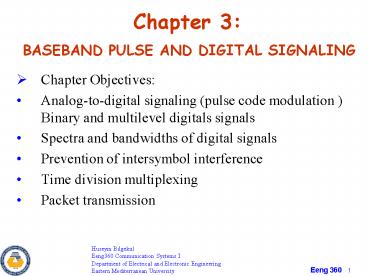Eeng 360 1 - PowerPoint PPT Presentation
1 / 13
Title:
Eeng 360 1
Description:
Chapter 3: BASEBAND PULSE AND DIGITAL SIGNALING Chapter Objectives: Analog-to-digital signaling (pulse code modulation ) Binary and multilevel digitals signals – PowerPoint PPT presentation
Number of Views:67
Avg rating:3.0/5.0
Title: Eeng 360 1
1
Chapter 3 BASEBAND PULSE AND DIGITAL SIGNALING
- Chapter Objectives
- Analog-to-digital signaling (pulse code
modulation ) Binary and multilevel digitals
signals - Spectra and bandwidths of digital signals
- Prevention of intersymbol interference
- Time division multiplexing
- Packet transmission
Huseyin Bilgekul Eeng360 Communication Systems
I Department of Electrical and Electronic
Engineering Eastern Mediterranean University
2
INTRODUCTION
- This chapter we study how to encode analog
waveforms into base band digital signals. Digital
signal is popular because of the low cost and
flexibility. - Main goals
- To study how analog waveforms can be converted to
digital waveforms, Pulse Code Modulation. - To learn how to compute the spectrum for digital
signals. - Examine how the filtering of pulse signals
affects our ability to recover the digital
information. Intersymbol interference (ISI). - To study how we can multiplex (combine) data from
several digital bit streams into one high-speed
digital stream for transmission over a digital
system Time-division Multiplexing.
3
PULSE AMPLITUDE MODULATION
- Pulse Amplitude Modulation (PAM) is used to
describe the conversion of the analog signal to a
pulse-type signal in which the amplitude of the
pulse denotes the analog information. - The purpose of PAM signaling is to provide
another waveform that looks like pulses, yet
contains the information that was present in the
analog waveform. - There are two classes of PAM signals
- PAM that uses Natural Sampling (gating)
- PAM that uses Instantaneous Sampling to produce a
flat-top pulse.
4
Natural Sampling (Gating)
- DEFINTION If w(t) is an analog waveform
bandlimited to B hertz, the PAM signal that uses
natural sampling (gating) is - ws(t) w(t)s(t) Where
- S(t) is a rectangular wave switching waveform and
fs 1/Ts 2B. - THEORM The spectrum for a naturally sampled PAM
signal is - Where fs 1/Ts, ?s 2p fs,
- the Duty Cycle of s(t) is d t/Ts ,
- W(f) Fw(t) is the spectrum of the original
unsampled waveform, - cn represents the Fourier series coefficients of
the switching waveform.
5
Natural Sampling (Gating)
w(t)
s(t)
ws(t) w(t)s(t)
6
Generating Natural Sampling
- The PAM wave form with natural sampling can be
generated using a CMOS circuit consisting of a
clock and analog switch as shown.
7
Spectrum of Natural Sampling
- The duty cycle of the switching waveform is d
t/Ts 1/3. - The sampling rate is fs 4B.
8
Recovering Naturally Sampled PAM
- At the receiver, the original analog waveform,
w(t), can be recovered from the PAM signal,
ws(t), by passing the PAM signal through a
low-pass filter where the cutoff frequency is
B ltfcutoff lt fs -B - If the analog signal is under sampled fs lt 2B,
the effect of spectral overlapping is called
Aliasing. This results in a recovered analog
signal that is distorted compared to the original
waveform.
LPF Filter B ltfcutoff lt fs -B
9
Demodulation of PAM Signal
- The analog waveform may be recovered from the
PAM signal by using product detection,
10
Instantaneous Sampling (Flat-Top PAM)
- This type of PAM signal consists of
instantaneous samples. - w(t) is sampled at t kTs .
- The sample values w(kTs ) determine the
amplitude of the flat-top rectangular pulses.
11
Instantaneous Sampling (Flat-Top PAM)
- DEFINITION If w(t) is an analog waveform
bandlimited to B Hertz, the instantaneous sampled
PAM signal is given by - Where h(t) denotes the sampling-pulse shape and,
for flat-top sampling, the pulse shape is,
THEOREM The spectrum for a flat-top PAM signal
is
12
The spectrum of the flat-top PAM
- Analog signal maybe recovered from the flat-top
PAM signal by the use of a LPF.
LPF Response Note that the recovered signal has
some distortions due to the curvature of the
H(f). Distortions can be removed by using a LPF
having a response 1/H(f).
13
Some notes on PAM
- The flat-top PAM signal could be generated by
using a sample-and-hold type electronic circuit. - There is some high frequency loss in the
recovered analog waveform due to filtering effect
H(f) caused by the flat top pulse shape. - This can be compensated (Equalized) at the
receiver by making the transfer function of the
LPF to 1/H(f) - This is a very common practice called
EQUALIZATION - The pulse width t is called the APERTURE since
t/Ts determines the gain of the recovered analog
signal - Disadvantages of PAM
- PAM requires a very larger bandwidth than that of
the original signal - The noise performance of the PAM system is not
satisfying.































